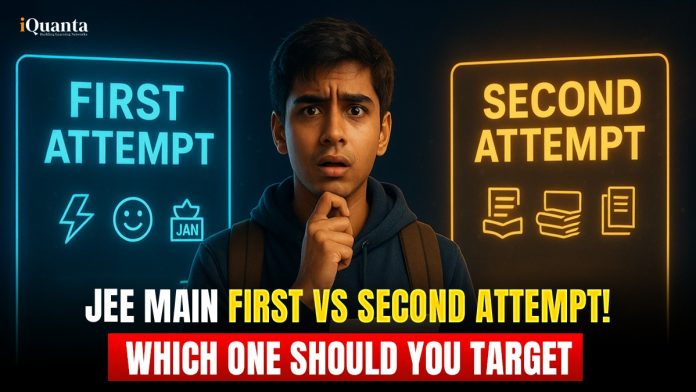JEE Main Attempts: IIT JEE is the dream exam for many engineering students who want to pursue their engineering degree from top engineering institutions. Every year, lakhs of JEE aspirants appear for the JEE Main exam. This exam is conducted by National Testing Agency (NTA) and considered it one of the most competitive exams in India with more than 12 lakhs students registering for this exam every year. A unique feature for the JEE Main exam is that it is held twice a year, the first attempt is in the January session and second attempt is in the April session. The NTA government body follows the best of two scores approach for the students appearing for the exam, which means your highest percentile either from your first attempt or second attempt considered for admissions and JEE Main Counselling 2026.
The one question that arises in the mind of almost every JEE aspirant is whether I should target the JEE Main first attempt or the second attempt? Both the JEE Main attempts have their own advantages and challenges. In this blog we will be talking about comparison, advantages and strategy on whether you should attempt JEE Main first vs second attempt to help you decide the best preparation strategy to cover for JEE Main 2026.

Join this free JEE Prep Group to Get Free Study Material, Preparation Strategy by Toppers, Latest Updates and More!
What is the JEE Main Exam?
The JEE Main exam is one of the toughest and most competitive exams in India and it is conducted by NTA. This exam serves as the eligibility for the JEE Advanced as well as make a candidate eligible to take admission to undergraduate engineering programs like B.E., B.Tech, B.Planning as well as B.Arch in top engineering colleges (NITs, IIITs & GFTIs).
Every year in India more than 12 lakhs engineering aspirants register for the JEE Main exam and it is conducted twice a year (January as well as April sessions).
| Features | Details |
| Exam Name | Joint Entrance Examination – Main (JEE Main) |
| Conducting Body | National Testing Agency (NTA) |
| Purpose | Admission to NITs, IIITs, GFTIs + Eligibility for JEE Advanced |
| Courses Offered | B.Tech, B.E., B.Arch, B.Planning |
| Mode of Exam | Online (Computer-Based Test) |
| Attempts | Twice a year (January & April) |
| Score Considered | Best of two attempts |
| Approx. Candidates | 12–13 lakh annually |
JEE Main First vs Second Attempt (Overview)
The JEE Main exam is the dream entrance competitive exam for many engineering aspirants. With more that 12 to 13 lakhs aspirants appear every year in the exam and to make this whole process flexible, NTA introduced the system of two attempts every year and that is starting in 2019.
First Attempt (January Session): The first attempt of the JEE Main exam is usually held at the first or second week of January. For many students, this session is the first exposure to face the real JEE Main exam. Since another attempt is available later in the year and with this approach students face less pressure on them. This both acts as a serious opportunity to many many JEE aspirants so that they will score well in the exam.
Second Attempt (April Session) : The second attempt of the JEE Main exam is usually held at the April session after the class 12th board examination. The second attempt gives JEE aspirants an additional 2-3 months to revise their weak topics and practice mock tests. Students often perform better in this attempt to get into their dream college. The best feature of this system is that they follow the best of two policies.
The JEE main first vs second attempt reduces the exam pressure, provides flexibility to JEE aspirants and ensures that a single bad day does not ruin your entire year or preparation journey. This allows aspirants to use the first attempt to set the benchmark or consider it as their trial without any pressure so that they will strategically target their second attempt for maximum improvement.
| First Attempt (January Session) | Second Attempt (April Session) |
| January | April |
| Limited time as it comes right after pre-boards/board prep | Extra 2–3 months for revision & practice |
| Lower Chances | Higher (last opportunity in a year) |
| First attempt to actual JEE Main exam conditions | Students are already familiar with exam pattern & environment |
| High for well-prepared long-term aspirants | Generally higher as students correct mistakes from January |
| Sometimes works as a trial | Stronger attempt for most aspirants |
Advantages of JEE Main First Attempt
The January attempt of JEE Main exam gives students a real exam environment to check on their preparation level. Since another attempt for the JEE Main exam is still available, aspirants face less exam pressure and are able to score well in the exam. A good score in the very first attempt of the exam boosts confidence level and even allows candidates to shift their focus now towards preparing for JEE Advanced.
There are five points mentioned below that serves as the advantages of JEE Main first attempt:
- This attempt acts as a reality check for many aspirants so that they will identify their strengths and weaknesses at an early stage.
- A good score in a very first attempt boosts JEE aspirants confidence level
- Students feel less exam pressure since another attempt is available in a year.
- This attempt helps students balance their board examination and prepare for the entrance exam effectively.
- It is best suited for the dropper candidates and long-term aspirants who are fully prepared for the JEE Main exam.
Advantages of JEE Main Second Attempt
There are some advantages that aspirants are having when they will go for the JEE Main second attempt 2026:
- The JEE Main second attempt provides extra 2 to 3 months to the aspirants for their revision and concept strengthening.
- It usually becomes one of the stronger JEE Main attempts for many JEE aspirants.
- In JEE Main second attempt, students can learn from their mistakes that they made in their January session.
- Aspirants become familiar with the exam pattern due to their first attempt so this leads to better time management in the second attempt of the JEE Main exam.
- The JEE Main second attempt offers aspirants to secure top NITs/ IITs with a better score.
Detailed Comparison between JEE Main 1st vs 2nd Attempt
Both JEE Main first vs second attempt in the January and April session are designed to give flexibility to many aspirants, reduce exam pressure as well as increase the chances of scoring better. In this section we have compared both the JEE Main 1st vs 2nd attempt and the detailed information mentioned in the table below:
| First Attempt (January) | Second Attempt (April) |
| Conducted before Class 12th boards | Conducted after boards (for most students) |
| Comes right after pre-boards leads to less revision time | Extra 2–3 months for practice & corrections |
| Comparatively low since another chance is left | Higher as it is the last chance in the year |
| Works as a trial run + real attempt | Students are more experienced and focused |
| High for droppers & long-term aspirants | Higher for most students due to corrections |
| Early confidence boost + frees time for JEE Advanced prep | Strongest attempt for securing NIT/IIIT admissions |
JEE Main First vs Second Attempt – Which One Should You Target?
Choosing between the JEE Main first vs second attempt depends on the aspirants preparation level, overall study strategy as well as confidence level. Since the better percentile score from either first or second attempt is always considered for the admission and the JEE Main counselling 2026. For the aspirants who are droppers or long-term aspirants who have already completed the syllabus and practice for a long time, the January session proves to be the best.
On the other hand, class 12th appearing students usually benefit more from the second attempt that is the late April session because it provides extra time after the board exam to revise the concepts well and strengthen weak concepts. Many aspirants adopt a balanced pattern for their preparation of both the JEE Main first attempt vs second attempt.
Conclusion: JEE Main Attempts
The introduction of these two JEE Main attempts by the conducting body NTA proves a friendly move to many JEE aspirants as it not only reduces exam pressure but also helps them achieve better scores in both the JEE Main attempts. Both attempts come with their own unique advantages to the students and allows them to correct their mistakes, utilize preparation time and maintain accuracy in the real exam. Success in JEE Main exam comes with confidence not only just about choosing one attempt, aspirants can maximize their chances of securing admissions in top NITs/ IIITs and even qualifying the toughest JEE Advanced.
Click Here to Enroll to JEE 2026 Course!

JEE Main First vs Second Attempt FAQs
Q1. Is the first attempt of JEE Main easier than the second attempt?
No, both attempts follow the same JEE exam pattern and level of difficulty. Aspirants perform better in the second attempt mostly due to their improved preparation.
Q2. Can I appear in both JEE Main attempts?
Yes, NTA allows JEE aspirants to sit for both JEE Main attempts and the better percentile score of the two will be considered for JEE Main counselling as well as for admissions.
Q3. Which attempt of JEE Main is more important?
Both the JEE Main attempts are equally important until aspirants achieve higher percentiles.




